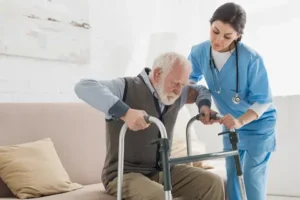Establishing a safe, supportive living space is essential for seniors who wish to age in place. A well-prepared home not only promotes independence but also provides peace of mind for families and caregivers. This guide explores common household risks and practical solutions for preventing accidents and enhancing quality of life.
Home safety is about more than avoiding accidents—it’s about empowering older adults to maintain their independence in familiar surroundings. A few strategic modifications can significantly reduce the risk of falls, burns, medication errors, and emergency delays. When safety becomes part of the home design, seniors are better equipped to thrive on their own terms.
Organizations like AARP offer valuable resources for caregivers and seniors alike. For additional insights, view our article on how to make home safer for elderly.
Performing a room-by-room assessment is the first step toward improving safety. Look for the following common risk factors:
| Common Risk | Description |
|---|---|
| Slips and Falls | Cluttered walkways, uneven flooring, and poor lighting create tripping hazards. |
| Fire Hazards | Outdated appliances, overloaded outlets, and absent smoke detectors increase fire risk. |
| Medication Errors | Disorganized medications can lead to skipped doses or overdosing. |
| Delayed Emergency Response | Without an emergency plan, seniors may struggle to get help quickly. |
For a structured approach, download our Senior Home Safety Checklist.
Addressing high-risk areas of the home—namely the bathroom, kitchen, and bedroom—can reduce the likelihood of injuries while improving accessibility.
| Feature | Purpose |
|---|---|
| Grab Bars | Provides support during transfers near the toilet and shower. |
| Non-Slip Mats | Prevents slipping on wet tile or linoleum floors. |
| Raised Toilet Seat | Makes sitting and standing less physically demanding. |
| Walk-In Tub | Reduces the risk of falls when entering or exiting the tub. |
Explore more solutions in our fall prevention guide.
Read more tips on our elderly home safety tips page.
For more ideas, see our complete home modifications for seniors guide.
Modern smart home tools are designed to enhance safety and ease for seniors. When integrated thoughtfully, these technologies reduce risk and promote independence.
Discover more in our elder care safety products section.
Learn how to create a plan with our emergency preparedness for seniors guide.
Safety doesn’t stop with modifications—it extends to the people and resources involved in a senior’s care. Access to reliable support is crucial.
| Resource | Purpose |
|---|---|
| AARP | Guides on home safety and smart technology for caregivers. |
| Local Support Groups | Provides peer support and shared experiences for caregivers. |
| Online Communities | Forums to exchange advice and emotional support. |
A safe home environment empowers seniors to live with confidence and independence. With the right tools, technologies, and support networks, families can reduce risks and promote healthy aging in place. Visit the Thrive @ Home Network for trusted advice, product recommendations, and access to local service providers who specialize in creating senior-safe homes.oc

Here are a few hot topics usually covered:
| Topic | Description |
|---|---|
| Fall Prevention | Tricks and tips to minimize those pesky slips with home tweaks and simple safety advice. |
| Medication Safety | How to keep track of meds safely without making things complicated. |
| Emergency Preparedness | Setting up an ‘in-case-of’ plan with all the right numbers and escape routes. |
Programs like these aren’t just info dumps; they actively empower communities and families to stage-manage a safer space for their elderly relatives.
Shouting from the rooftops might be a bit dramatic, but when it comes to making sure senior policies are family-centered, it’s close. Getting behind advocacy programs can really put the spotlight on making changes that count, nudging those up high to roll out the right kind of support.
Ways to chip in include:
Join in these efforts, and you’re setting the stage for a happier, safer home life for our older friends and family, making sure they get to relish their golden years with dignity and independence. Dive deeper into the rabbit hole with helpful guides like elderly home safety tips and home modifications for seniors.
Send Us An Email